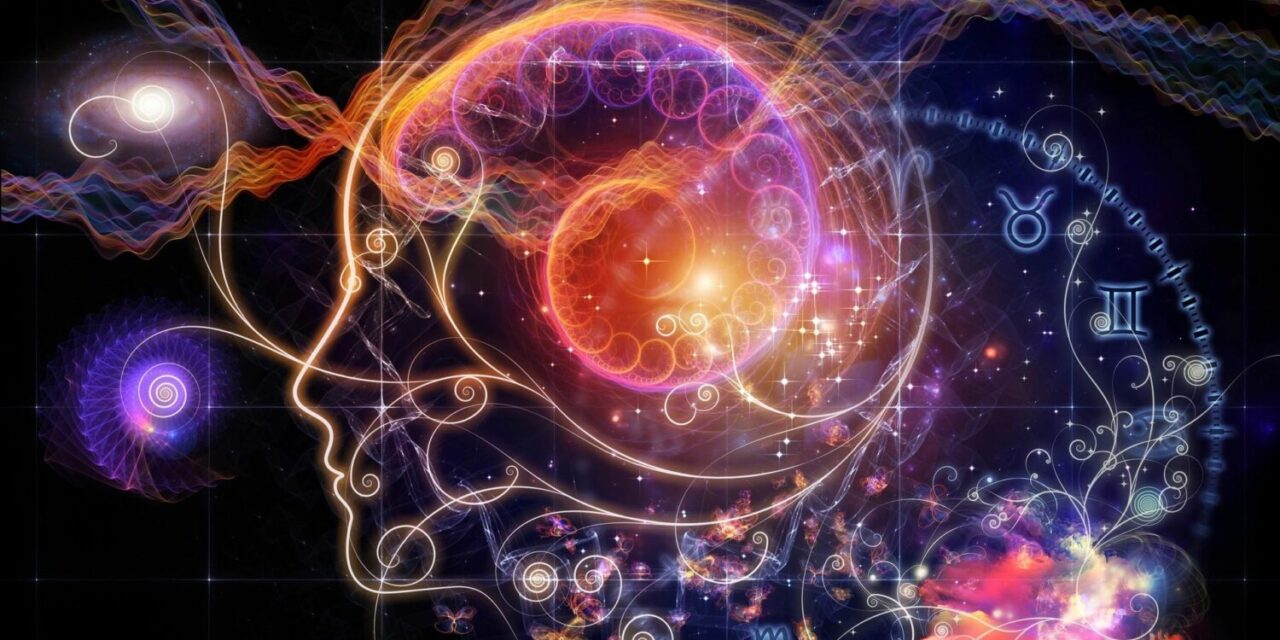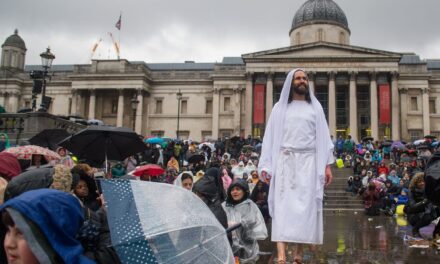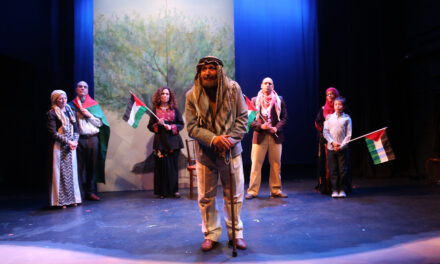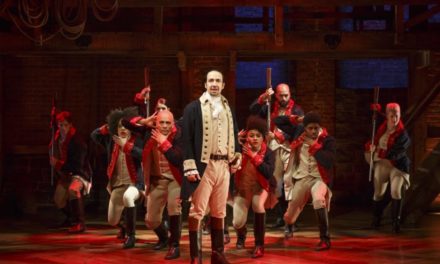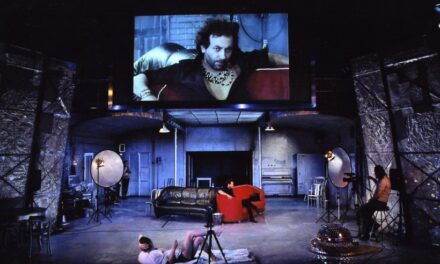For more than four decades the visual artist Joan Jonas, representing the U.S. in the 2015 Venice Biennale, has been generating a highly refined vocabulary of forms. In her most recent work, Reanimation, she brings together multiple technologies of performance: drawing, movement, video, text, sound, photography. All of these elements demonstrate the process of making art the moment it is occurring in the performance event, at the center of which is the embodied artist—drawing the work, making sound and movement, speaking text (passages from the Halldór Laxness novel, Under the Glacier). Her life-long interests are now elaborated in performance time through its relation to cosmic time, the ecological is positioned next to interspecies communication, the ritualistic accompanying the mediated. Whether from the point of view of mediaturgy or posthuman or poetics, in Reanimation Jonas draws her way through space and time, mapping a spiritual journey.
New York-based artist Joan Jonas has helped shape the histories of performance and video. She began her artistic work in the 1960s, and is widely admired for her achievements in film, performance, video, sculpture, installation, photography, and drawing. She represented the United States at the Venice Biennale in 2015. There has been a very clear throughline in her body of work, dating back to such early performances as Organic Honey’s Visual Telepathy (1972), Vertical Roll (1972), Mirror Pieces (1968-1971), Double Lunar Dogs (1984), The Juniper Tree (1976), Volcano Saga (1985), and up to the last dozen years with Lines in the Sand (2002), The Shape, the Scent, the Feel of Things (2004), Reading Dante (2009) and Reanimation (2012), which will be my focus here. The consistency of her work, at the center of which is her own body, is most apparent in the mirroring and filming of images, in its incorporation of myth, mask, and ritual, in the act of drawing as a performance element, and in her attention to nature and animals. Her worldview moves between the ancient and the contemporary or, to put it another way, between folk culture and avant-garde ideas.
Encompassing all of those qualities in the poetics of performance, the artist’s most recent work, entitled Reanimation, was first performed in 2012 in Kassel, Germany, at dOCUMENTA 13, and that same year again in New York at the Performa Biennial. Reanimation exemplifies the multiplicity of Jonas’s vision in its numerous technologies of performance: drawing, video, photography, movement, music, literature. Jonas points to the new ecology of arts, with all of the elements in a single work shaping the intertwined tracks of text, action, video, light, and sound. Reanimation, made with the composer and jazz musician Jason Moran, takes as a point of departure the 1968 novel Under the Glacier, by the Nobel Prize-winning Icelandic writer Haldór Laxness. Susan Sontag wrote an introduction to a new edition of the novel (the last essay Sontag wrote before her death in 2004), praising its uniqueness in encompassing so many kinds of writing: science fiction, philosophy, dream, comedy, and allegory – a veritable “anti-fictional fiction.” All of these categories suit Joan Jonas, who takes her inspiration from poetry, myth, and image, and, in particular, Nordic culture.
Perhaps I should mention that Jonas draws her way into the world of the work she is making. For Reanimation is not a performance about a particular subject, but rather one that demonstrates its process of being made through various technologies of performance, primarily drawing. In the very act of drawing Jonas develops a relationship to the video image and projections of photographs, maps, and news clippings, responding to them literally as works on paper. The performance is unfolding while she is also drawing it, and being watched in her drawing process by the audience. She is both narrating and embodying the narrative, and in her distinctive matter-of-fact, uninflected voice, she recites fragments of the novel, live and pre-recorded. The subject matter encompasses human and animal species in the landscape, natural disasters, the lives of flowers, comings, and goings of birds and bees, and philosophical reflections on light, the body, history, and time. Natural history is inseparable from the history of the world.
The varieties of time bring a profound dimension to the work in its encompassing of cosmic time, performance time, and documentary time. The glacier at the heart of the story exists as a solid mass that in another state is also capable of melting. Thus, it is a transformational medium. In Reanimation, structured as it is by process, which is just another name for transformation, performance history is brought together with natural history. The climate of this world is constantly changing through the chaotic, uncontrollable natural forces of snow, glaciers, storms, and lightning that also allow for bright sun and calming waters. Jason Moran’s live music, often percussive, and continuous throughout Reanimation, can make piano keys sound like icicles and the images of water ripple like Debussy. The sound design is not mere accompaniment; it is integral to the performance process. As Jonas explains, “it was part of my body and my space.”
If Jonas offers only the barest selection of images and extracts from the novel, all the while she responds to its philosophical grandeur in the performance space, even drawing over the moving video images of the landscape, and the animals, objects, and people inhabiting it. The act of drawing generates the flow of the performance. Drawing is not seen as a discrete activity. It is never used as an opportunity to glorify “THE ARTIST WORKING” in any self-conscious sense, because Jonas, who frequently draws standing at a waist-high table to the side of the film screen, casually tosses the drawings she’s just made onto the floor next to her. She also did that in another recent work, Reading Dante. Jonas is drawing her way into the images, many of which are her own; for example, she draws over her own video footage and outlines images in her own photographs, as if to generate a new experience from memory. A video camera records her in the act of drawing and projects it on the screen. More and more it seems to me that for Jonas, drawing is a form of speech. Everything functions as visual language.
Jonas, in a kimono-like robe, ruffled tunic, slippers, and leggings – all in white – at times wearing a fanciful blue hat, acts as a conjurer, turning images from one medium into another. She dances in front of the screen blowing on a whistle and waving noisy shakers, losing herself in a video landscape of shimmering conical forms that generate translucent patterns. Her visionary cinema suggests a symbolist belief in the image as a source of knowledge. There is an acceptance of its mystery and supernatural force. At some moments during the performance Jonas is standing in front of the screen as the surface of her body merges with it; at other times she is at her table speaking the Laxness text, or drawing or manipulating material. (An assistant, who sits off to the side, sometimes helps with the technical elements, though she is never conspicuous in the narrative.)
Jonas draws looking at the screen or turned away from it; the drawing has its own life. She occasionally sits at the opposite side of the performance space at a low table a few inches from the floor, blowing on a toy horn. Nearby is an easel she sometimes draws on. She also performs in front of the screen, for example, wearing a mask and drawing an outline of a body over her own body. By her own admission, Jonas experiences drawing in performance as ritual. In the last scene of the work, she seems in a trance, sitting at the small table, wildly lost in her shaking of bells and noise-makers while in the video image the shadow of a tall figure is walking across a snowy landscape. Then she reads from the text: “Time is the one thing we can all agree to call supernatural. It is at least neither energy nor matter; not dimension either; let alone function: and yet it is the beginning and the end of the world.” The nature of time is complicated in this work because of the tension between the live figure and the mediated image that overlaps. It gives the feeling of Jonas wanting to get inside the landscape, to follow the novel’s characters into the center of the earth. Drawing is movement, travel. In a very real sense, Reanimation is a journey, perhaps even a quest.
Jonas is frequently seen drawing for the camera, which is videotaping her drawing as she is standing at the table while simultaneously projecting the drawing over the image on the screen in a layering effect. Sometimes she is not even looking at the paper. In other segments, she is drawing with an oil stick on the end of a long stick that elongates her arms. In her work Lines in the Sand, she drew with a rake in a sandbox. In The Shape, the Scent, the Feel of Things she drew abstract shapes on black photographic paper on the floor. Reanimation is brought to life through the relation of drawing to the film image, to sound and text. It absorbs its force from multiple technologies. Perhaps her performances can also describe a new kind of synesthesia. “Drawing involves the body moving in different ways in space,” says Jonas.
In Reanimation she is a storyteller whose mediums of expression are drawing, image, text, music. In the work’s interdisciplinarity, art is understood as a language. I think of her approach to art-making as a “mediaturgy” that acknowledges no hierarchy between text and image as languages of a work. In fact, they move together toward resolution of the conflict between text and image that has played out over a century of performance practices. A wide diversity of theater artists can be set in the context of mediaturgy, including The Wooster Group, Meredith Monk, John Jesurun, Laurie Anderson, Gob Squad, and Societas Raffaello Sanzio. Likewise, application of the concept extends to visual artists since it encompasses image, storytelling, video, and photography, in the works of artists like Martha Rosler, Andrea Fraser, Akram Zaatari, Gary Hill, Carolee Schneemann, and William Kentridge. The ground for contemporary performance and media explorations now lies in a range of forms that alternate between live presence and screen presence.
Mediaturgy can be understood as the construction of narrative inseparable from image-making in the work process. If narrative is challenged by the rhetoric of the image, so also are body, character, and scene. The task of the viewer is not merely to switch back and forth between media, but to comprehend the live performer and the digital image as an integrated experience. This manner of looking reflects the complexity of spectatorship in our era. Mediaturgy presents a further development from the earlier “Intermedia,” which is an interdisciplinary poetics, and “the Theater of Images,” in which the human figure in real-time and real space prevailed, and there was more interest in the plane than the screen. A mediaturgy for today requires the viewer to comprehend an event that takes place in physical space and mediated space while offering no fixed perspective – only altered modes of perceiving space and time, image and text, bodies and their transformations.
The references to media shouldn’t give the impression that Reanimation is dominated by an excess of new technology. In actuality, it is surprisingly “low tech” – a study of the way an artist works with materials, in the full presence of the spectator. A “low tech” example is the creation of percussive “sound effects” made by crumpling paper near a microphone. Or, a plastic sheet manipulated in front of the camera is projected live over video images of water to make a luminous overlay. In another instance, ink is ingeniously poured on paper and Jonas draws with ice cubes that melt into abstract images projected on the screen for a parable about the dandelion and the bee. Yet again, she plays with simple child’s toys like horns and bells to generate sound. Little mechanical dolls and toy animals are moved around in water for surprising effects in one video sequence. In the same scene, the small video camera at her table captures loose marbles that are spread in all directions while she makes chalk scribbles with her movements, layering this activity on the watery screen image. If Reanimation reflects the worldliness of Jonas, it also highlights the value she gives to ordinary things.
What is always evident is the integrity of objects. After all, Jonas is also a sculptor. Similarly, there is a sense of privacy in the work; hers is the art of a dreamer, a reader, a woman who respects an economy of means and the unfathomable nature of the universe. There is a certain poignancy in observing an artist who retains a child-like wonder as she approaches her eightieth year – a gift sparingly given to older filmmakers, as in the case of Fellini, Bunuel, Bergman or Varda.
Humans, dolls, animals, objects – all species are honored in this work that takes as its purview the cosmos – earth, sky, and sea. In the Jonas bestiary, there are horses, sea lions, fish, birds, bees, and polar bears. In one of the most transformative scenes of Reanimation, Jonas is sitting on the floor in front of the screen, whose image shows a large number of goats. In this humorous scene, it looks as if she is inhabiting the same space, with the surface of her body and the surface of the screen in effect merging. The goats are making lots of noise and Jonas, arms raised, is waving rattles through this cacophony of transspecies dialogue, as if she were living in a new society. Long before animal studies became a branch of performance studies or before anyone spoke of the posthuman, Jonas had been populating her works with her animal friends, particularly her beloved dog Zina.
If the story of the dandelion and the bee transmits one lesson of the natural world, the snow bunting offers another. The little bird is observed in three narrative forms: text, drawing, video. A telling passage from Under the Glacier is heard in Jonas’s voice on tape:
It’s a pity we don’t whistle at one another like birds. Words are misleading. I am always trying to forget words. That is why I concentrate on the lilies of the field but in particular the glacier. If one looks at the glacier for long enough words cease to have any meaning on earth.
The text fragment presents the listener with the dilemma of measuring language against the immensity of nature, especially where spiritual matters are concerned.
Of course, it is only a short step from any nature references to the ecological condition that is our legacy. Nonetheless, Reanimation is not a statement or documentary. Jonas’s poetic mode of performance opens up to a landscape of imagination, of light and dark and symbols and ghosts, of technologies and ritual, of multiple species and animate objects, of myth and modernity where the spectator is invited to wander in search of meaning and metaphor. At its most transcendent, the work is an “animation” of the Laxness novel. The wisdom and clarity and courage that we seek in older artists are in this work. Some may refer to it as “late style.” I regard Reanimation as a chamber piece manifesting the aspirations of literature and myth – a bestowal of gravitas on performance art in the twenty-first century.
Joan Jonas … oh, lady in white … dancing in the snow … How do you turn media into magic and a blank sheet of paper into a line leading to eternity?
This article was originally posted by Archée on October 28, 2019, and has been reposted with permission. To read the original article, click here.
This post was written by the author in their personal capacity.The opinions expressed in this article are the author’s own and do not reflect the view of The Theatre Times, their staff or collaborators.
This post was written by Bonnie Marranca.
The views expressed here belong to the author and do not necessarily reflect our views and opinions.

